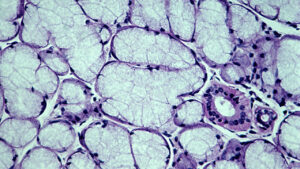Posted on January 30, 2023 in ASRC News, Nanoscience Initiative

Mucus gets a bad rap. Sure, the slippery, gelatinous goo produced by mucous membranes can be off-putting for some, but its capabilities are nothing to sneeze at. Organic mucus is a vital protective substance that allows bodies to perform essential functions, such as breathing, swallowing, and digesting. Animal mucus can provide filtrative, conductive, or adhesive functions that are useful to drug delivery and cosmetic industries. The downside about organic mucus, however, is its variability in samples and parasitic contamination, which can lead to structural degradation and toxicity. With the help of funding from the ASRC SEED Grant Program, Sophia Suarez, professor of physics at Brooklyn College, and colleagues are working to overcome these obstacles by studying synthetic mucus.

In the proposal titled “The Role of Calcium Content on the Transport and Resistive Properties of Synthetic Mucus,” Professor Suarez, Adam Braunschweig (CUNY ASRC Nanoscience Initiative), and Steven Greenbaum (Hunter College) set forth their goal to understand the relationship between the structure and function of synthetic mucus. “Our project will focus on the microscopic dynamic behaviors and the effect of calcium concentration in synthetic mucus,” says Professor Suarez. Mucus properties are dependent upon characteristics such as sequence and polymer molecular weight, and both can affect the efficacy and efficiency of the mucus application. Therefore, it’s important to understand the relationship and structure of synthetic mucus to expand its availability and application in industries.
In addition to making synthetic mucus and other materials, the researchers will use a variety of experimental techniques, including multi-nuclear (1H and 43Ca) magnetic resonance (NMR) and electrochemical impedance (EIS) spectroscopy techniques to access dynamical information. “This combination of techniques allows us to probe different time scales (micro to milli seconds) and types (rotational and translational) of motions,” says Professor Suarez.
Through this research, Professor Suarez also aims to “Enhance the participating students’ knowledge, research experience, and interest in pursuing higher graduate studies and careers in STEM disciplines.” The students working on the project will learn how to make novel synthetic polymers and conductive materials, as well as how to tune and characterize their important properties. In addition to providing the students with a new appreciation for mucus, this interdisciplinary project may also spark their interest in a new discipline. The ASRC SEED Grant Program, which supports creative, collaborative, and convergent research that addresses complex questions relevant to the most pressing challenges in STEM, will gather all award winners to present their research at its annual symposium later this year.
